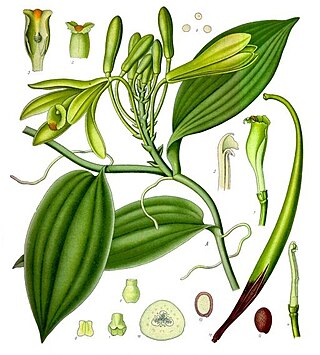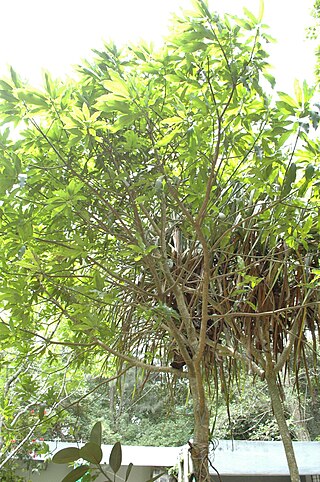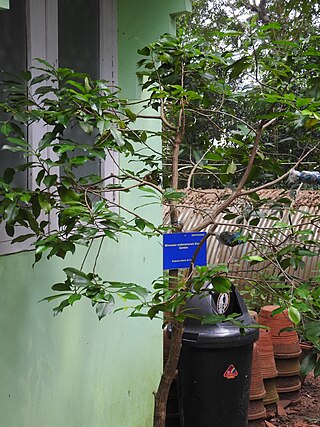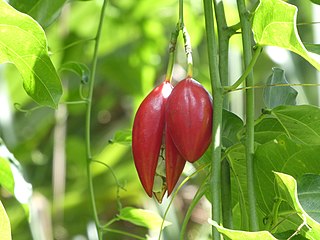
Aerides, known commonly as cat's-tail orchids and fox brush orchids, is a genus belonging to the orchid family. It is a group of tropical epiphyte orchids that grow mainly in the warm lowlands of tropical Asia from India to southern China to New Guinea. They are valued in horticulture for their racemes of showy, fragrant, colorful flowers.

The Madras Crocodile Bank Trust and Centre for Herpetology (MCBT) is a reptile zoo and herpetology research station, located 40 kilometres (25 mi) south of the city of Chennai, in state of Tamil Nadu, India. The centre is both a registered trust and a recognized zoo under the Wildlife (Protection) Act, 1972 and comes under the purview of the Central Zoo Authority, Ministry of Environment, Forest and Climate Change, Government of India. It was established with the aim of saving three Indian endangered species of crocodile—the marsh or mugger crocodile, the saltwater crocodile, and the gharial, which at the time of founding of the trust were all nearing extinction.

Abutilon menziesii, known as Koʻoloaʻula in Hawaiian, is an endangered species of flowering shrub in the family Malvaceae, that is endemic to Hawaii.

Bridelia is a plant genus of the family Phyllanthaceae first described as a genus in 1806. It is widespread across Africa, Australia, southern Asia, and various islands of the Indian and Pacific Oceans.

Eulophia andamanensis is an orchid found to occur among the Andaman and Nicobar group of Islands (off the east coast of India and also in the north-western tip of Langkawi island in Malaysia.The occurrence of this ground orchid in Andaman Islands is restricted to some isolated pockets of certain islands and rare. Living collections of this taxon from the Andaman Islands is under ex situ conservation outside the islands at the Field Gene Bank of Jawaharlal Nehru Tropical Botanic Garden and Research Institute, Trivandrum, India. It is a pre-tsunami accession.

"Jawaharlal Nehru Tropical Botanic Garden and Research Institute", renamed in the fond memory of visionary Prime Minister of India Shri Pandit Jawaharlal Nehru is an autonomous Institute established by the Government of Kerala on 17 November 1979 at Thiruvananthapuram, the capital city of Kerala. It functions under the umbrella of the Kerala State Council for Science, Technology and Environment (KSCSTE), Government of Kerala. The Royal Botanic Gardens (RBG), Kew played an exemplary and significant role in shaping and designing the lay out of the JNTBGRI garden in its formative stages.
India is home to a large variety of wildlife. It is a biodiversity hotspot with various ecosystems ranging from the Himalayas in the north to the evergreen rainforests in the south, the sands of the west to the marshy mangroves of the east. India lies within the Indomalayan realm and is home to about 7.6% of mammal, 14.7% of amphibian, 6% of bird, 6.2% of reptilian, and 6.2% of flowering plant species. India's forests contain about 500 species of mammals and more than 1300 bird species.

Botanical Survey of India (BSI) located in Kolkata, West Bengal, India. It was founded on 13 February 1890, is Government of India Ministry of Environment, Forest and Climate Change's organization for survey, research and conservation of plant wealth of India, flora and endangered species of India, including by collecting and maintaining germplasm and gene bank of endangered, patent and vulnerable plant species.

Vanilla planifolia is a species of vanilla orchid native to Mexico, Central America, Colombia, and Brazil. It is one of the primary sources for vanilla flavouring, due to its high vanillin content. Common names include flat-leaved vanilla, and West Indian vanilla. Often, it is simply referred to as "the vanilla". It was first scientifically named in 1808. With the species' population in decline and its habitats being converted to other purposes, the IUCN has assessed Vanilla planifolia as Endangered.

Bentinckia nicobarica is a species of flowering plant in the family Arecaceae found to occur in the Nicobar group of islands in the Bay of Bengal. It is an endemic palm occurring in Great Nicobar, Katchal, Nancowry and Car Nicobar Islands.

Mangifera andamanica belongs to the family Anacardiaceae and is endemic to the Andaman Islands in the Bay of Bengal. The fruits are edible and smaller than the Common Mango. This species is conserved at the Field Gene bank of Jawaharlal Neheru Tropical Botanic Garden and research Institute, Thiruvananthapuram, India.

Phalaenopsis micholitzii is a species of plant in the family Orchidaceae. It is endemic to the Zamboanga peninsula in the island of Mindanao, Philippines.

Rhynchostylis is a genus in the orchid family (Orchidaceae), closely allied to the genus Vanda and comprising four currently accepted species native to the Indian Subcontinent, China, Indochina, Malaysia, Indonesia and the Philippines.

Robiquetia, commonly known as pouched orchids, is a genus of flowering plants from the orchid family, Orchidaceae. Plants in this genus are epiphytes with long, sometimes branched, fibrous stems, leathery leaves in two ranks and large numbers of small, densely crowded flowers on a pendulous flowering stem. There are about eighty species found from tropical and subtropical Asia to the Western Pacific.

Pteroceras muriculatum is an endemic endangered orchid reported from the Andaman Islands in the Bay of Bengal. This insular orchid was first described by Reichenbach in 1881 as Thrixspermum muriculatum Rchb. f. based on a few specimens procured during the latter part of 19th century by Mr W. Bull. This taxon has not been reported until 2005 after the type collection. During the floristic survey of South Andaman Islands carried out by Sam Mathew for the 'Flora India Project' of the Botanical Survey of India, this taxon was relocated in 1993 from the semievergreen forests at Chidiyatappu region. Pteroceras muriculatum P. F. Hunt is a beautiful small epiphytic orchid having creamy white flowers with distinct transverse purple bands on petals. A living specimen collected from South Andaman Island is conserving at the Field Gene Bank of Jawaharlal Nehru Tropical Botanic Garden and Research Institute, Trivandrum, India.

Biogeographic classification of India is the division of India according to biogeographic characteristics. Biogeography is the study of the distribution of species (biology), organisms, and ecosystems in geographic space and through geological time. India has a rich heritage of natural diversity. India ranks fourth in Asia and tenth in the world amongst the top 17 mega-diverse countries in the world. India harbours nearly 11% of the world's floral diversity comprising over 17500 documented flowering plants, 6200 endemic species, 7500 medicinal plants and 246 globally threatened species in only 2.4% of world's land area. India is also home to four biodiversity hotspots—Andaman & Nicobar Islands, Eastern Himalaya, Indo-Burma region, and the Western Ghats. Hence the importance of biogeographical study of India's natural heritage.

Geodorum densiflorum, commonly known as pink nodding orchid or 地宝兰 , is a plant in the orchid family and is native to areas from tropical Asia to eastern Australia and some Pacific Islands. It is a terrestrial orchid with broad, pleated, dark green to yellowish leaves and up to and twenty pale pink flowers with dark red veins on the labellum. It grows in wetter habitats including rainforest, woodlands, grasslands and swamps.

Mimusops andamanensis is a species of plant in the family Sapotaceae. It is native to Sri Lanka and the Andaman Islands.
Piper ribesioides, also known as Lao chili wood, mai sakhaan, sankhaan, sankharn, sankahn or sakahn is a species of black pepper plant. The woody vine or stem of the plant has a hot, peppery and chili flavour, with a lingering aftertaste and slightly numbing sensation to the tongue. It is commonly used in Lao cuisine both in Laos and the predominately Lao ethnic region of Northeastern Thailand. It is the most important ingredient in Laos' famous Or lam. Its berries are sometimes pressed for an oil that is also used in cooking.

Adenia heterophylla, commonly known in Australia as the lacewing vine, is a climbing plant in the family Passifloraceae. It has a broad distribution spanning the equator, from the south eastern corner of China, through Indochina and Malesia, to northern Australia. In Australia it serves as a food plant for larvae of the glasswing, red lacewing and cruiser butterflies.


















